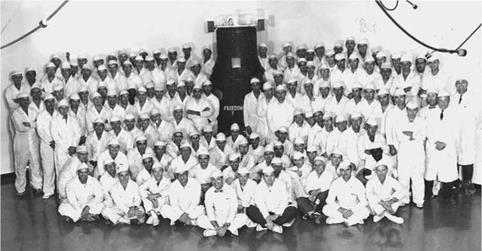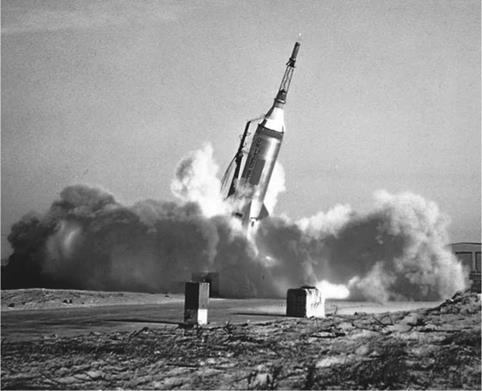FINAL CHECKOUT OF THE REDSTONE BOOSTER
Following an extensive evaluation of the MR-2 Redstone’s over-acceleration and harmonic vibration problems, it was reported that the reliability factor of the booster was well below the level required for NASA to confidently launch an astronaut into space.
Although the first manned flight with Alan Shepard as the prime pilot had already been scheduled for launch on 24 March 1961, there was a distinct feeling of unease in Washington, D. C. The president’s technical advisor on science issues, Jerome B. Wiesner, had recently been appointed to head the Science Advisory Committee and was advocating a far more cautious approach in what he perceived as something of a rush for NASA to launch an astronaut into space. Wiesner bluntly warned Kennedy that a dead astronaut would not do a lot for the young president’s administration, and he argued for several more chimpanzee launches to iron out any possible problems prior to committing to a manned flight. The new NASA Administrator, James Webb, and the head of the STG, Robert Gilruth, were brought into the discussion, holding consultations early in February with key Mercury personnel. Owing to some minor technical issues with Ham’s flight, and under pressure from the White House to be cautious, Wernher von Braun was advised there should be a delay in the first
human-tended mission. Instead, an unmanned proving flight of the booster would take place on the date previously allocated to MR-3.
As eager as he was to proceed with the manned flight, von Braun readily agreed with Webb and Gilruth – in fact, he had already been actively pressing for a further test flight, a “booster development launch” as he called it, although he was aware that it would not be possible to completely eliminate all risk. It was agreed that if this test proved successful, the manned MR-3 mission could proceed and the launch date was set for 25 April. It was a delay that arguably cost America the historical prestige of launching the first human being into space.
The new mission became known as the Mercury-Redstone Booster Development (MR-BD) flight. Its primary purpose was to verify the modifications made to prevent a recurrence of the flaws that afflicted the MR-2 flight. To prevent over-acceleration, the thrust regulator and velocity integrator were tweaked, and the vibration induced by aerodynamic stress in the upper part of the booster was remedied by adding four stiffeners to the ballast section and 210 pounds of insulation to the inner skin of the upper, instrument compartment section of the Redstone [13].
The MR-BD test would use an inert, expendable boilerplate Mercury spacecraft, and it was decided to reuse the one that had been retrieved after the Little Joe LJ-1B abort test mission on 21 January of that year. This capsule had been built at NASA’s Langley Research Center, ballasted and configured to match the production capsule that was to be used on the first manned flight. However, it was not equipped with a retrorocket package or posigrade rockets because these would not be required. It was
|
The Manufacturing, Quality Control, and various other classifications of workers at the McDonnell Aircraft Corporation plant in St. Louis, Missouri, gather around the completed Freedom 7 spacecraft, which would soon carry Alan Shepard into space. (Photo courtesy of Philip Kempland/McDonnell Aircraft Corporation) |
|
Little Joe LJ-1B, launched on 21 January 1960. The boilerplate capsule used on this primate flight was recovered, and would later be used on the MR-BD flight. (Photo: NASA) |
to be attached to the Redstone booster in the normal manner, but there would be no separation in flight. The escape rocket system, which was also inert, was a standard Mercury configuration utilizing spent rocket motors that were balanced to the correct weight for the MR-BD flight [14].
The LJ-1B flight had successfully carried Rhesus monkey Miss Sam on an eight – and-a-half minute test of the capsule’s escape sequence and landing systems. The boilerplate capsule had splashed down smoothly 12 miles from the Wallops Island launch site on the Atlantic coast, whereupon it was plucked from the sea by a waiting helicopter and returned to the launch site. Forty-five minutes after liftoff, an excited but otherwise healthy Miss Sam was extracted from the capsule.












